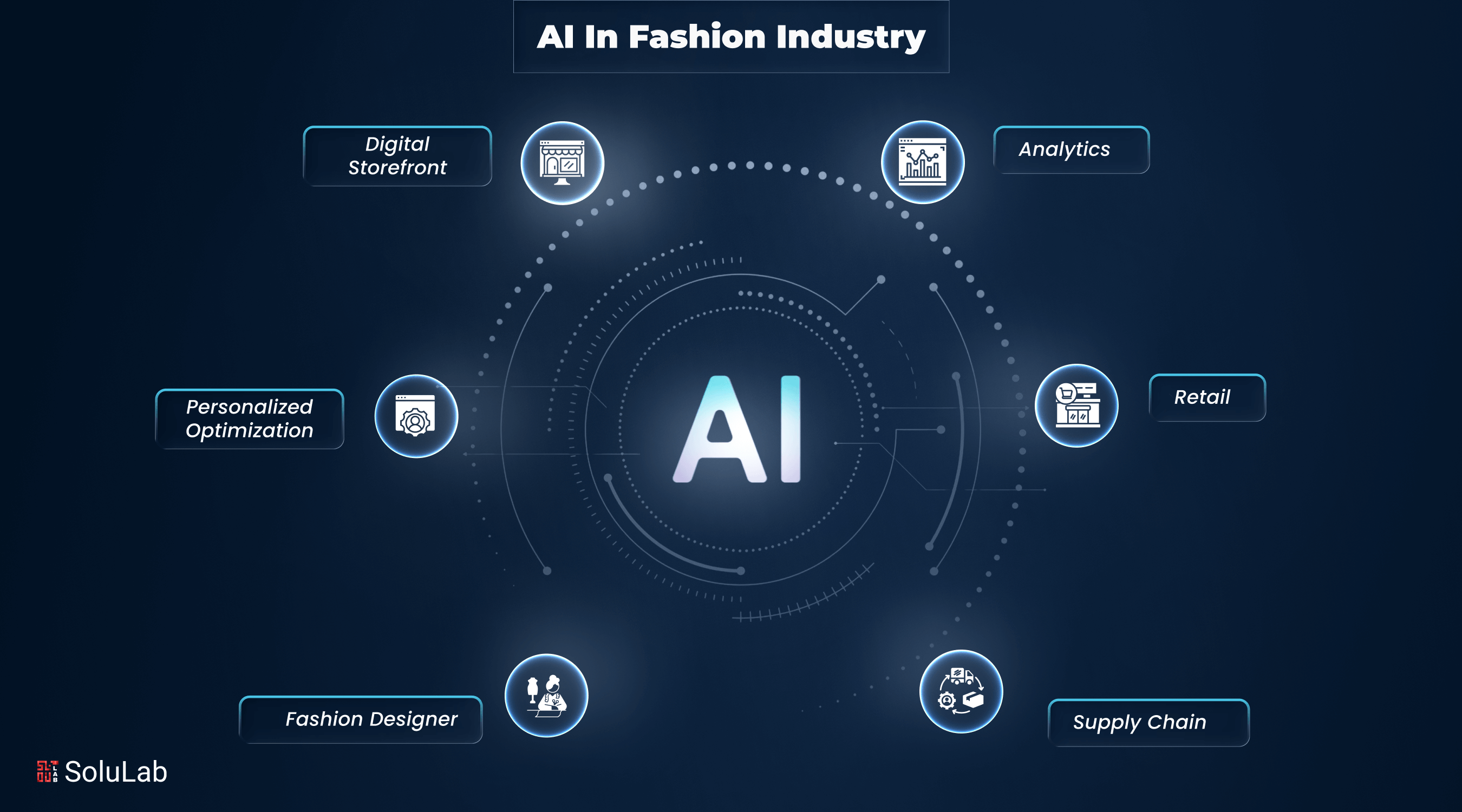
Fashion has always been about expression—but today, it’s also about intelligence.
Suppose you got an app that knows your style, predicts tomorrow’s trends, and even suggests outfits tailored to your body type– It might sound like a futuristic fantasy? But that’s the impact of Artificial Intelligence in fashion right now!
From personalized recommendations and virtual try-ons to AI-driven designs and sustainable production, AI is no longer just supporting fashion, it’s elevating it. In this blog, we’ll explore how Artificial Intelligence is reshaping the industry, making style smarter, shopping smoother, and fashion more personal than ever. Lets begin!
Adoption of AI in the Fashion Industry
| The global AI in fashion market is expected to reach around $4.4 billion by 2027, growing at a CAGR of approximately 40%. |
AI is changing the fashion industry by enhancing design, optimizing supply chains, personalizing shopping experiences, and predicting trends, helping brands stay competitive and customers feel more connected than ever.
1. AI-Driven Design Innovation: AI tools help designers create patterns, predict styles, and even generate complete outfit ideas. This speeds up the creative process while aligning designs with current and future fashion trends.
2. Personalized Shopping Experience: AI analyzes user behavior and preferences to recommend clothes that match individual needs. This creates a curated, customer-first shopping journey, boosting satisfaction and conversions for fashion brands.
3. Smart Inventory Management: AI predicts product demand accurately, helping brands stock only what’s needed. This reduces overproduction, minimizes waste, and ensures better management of fashion inventory and the warehouse.
4. Trend Forecasting and Consumer Insights: By scanning social media and fashion platforms, AI spots upcoming trends early. Brands can adapt faster to what’s in demand in the market.
5. Virtual Try-On Technology: AI enables virtual fitting rooms where users can “try on” clothes using AR and 3D modeling. This enhances the online shopping experience and reduces return rates.
6. Sustainable Fashion Practices: AI helps brands track and reduce their environmental impact. From optimizing fabric use to recommending sustainable materials, it supports eco-friendly decision-making in design and production.
Major Use Cases of AI in Fashion Industry
Artificial Intelligence is no longer a backstage tool—it’s walking the runway with fashion brands worldwide. There are many ways AI is reshaping the industry, some well-known AI use cases in fashion are:
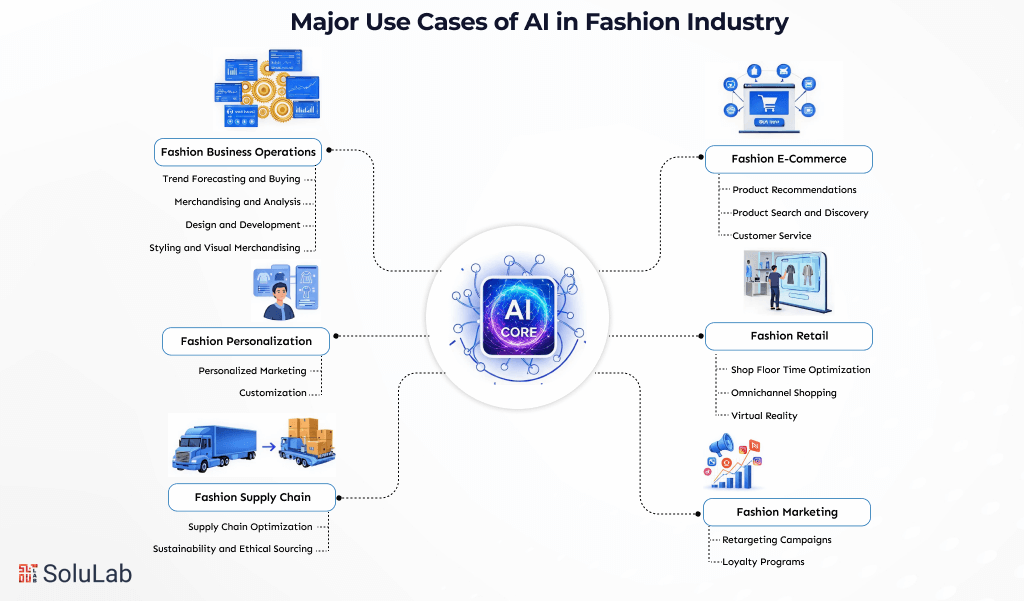
Fashion Business Operations
1. Trend Forecasting and Buying: AI drives trend forecasting and buying by analyzing social media, sales data, and fashion blogs. By spotting patterns in customer tastes and habits, it predicts upcoming trends, helping brands make smarter purchasing and design decisions that align with what’s in demand.
2. Merchandising and Analysis: AI optimizes inventory and assortment planning by analyzing sales data, trends, and customer preferences. This reduces overstock and stockouts, boosts efficiency, and maximizes profitability for fashion brands.
3. Design and Development: AI tools assist in creating design suggestions, optimizing patterns, and producing virtual prototypes. Designers can experiment with fabrics, styles, and colors, streamlining creativity and reducing design iterations.
4. Styling and Visual Merchandising: AI enhances product displays both online and offline by analyzing trends and customer preferences. It suggests styling options, outfit combinations, and virtual try-ons, creating a personalized and engaging shopping experience.
Fashion E-Commerce
1. Product Recommendations: AI analyzes browsing and purchase history to suggest products tailored to individual tastes, boosting purchase likelihood and fostering customer loyalty.
2. Product Search and Discovery: AI-powered search engines, visual search, natural language processing (NLP), and voice commands make finding products easier and faster, creating a seamless shopping experience.
3. Customer Service: AI chatbots and virtual assistants provide 24/7 support, answer queries, guide purchases, and offer personalized suggestions, enhancing efficiency and customer satisfaction.
Fashion Retail
1. Shop Floor Time Optimization: AI analyzes sales data and foot traffic to schedule staff efficiently, ensuring adequate coverage during peak times and avoiding overstaffing during quieter periods.
2. Omnichannel Shopping: AI integrates physical and online stores, keeping product info, pricing, and promotions consistent, creating a seamless shopping experience and boosting customer loyalty.
3. Virtual Reality: VR and AI enable virtual try-ons, letting customers see how clothes fit before buying. This reduces uncertainty, lowers return rates, and enhances satisfaction.
Fashion Marketing
1. Retargeting Campaigns: AI analyzes customer behavior to deliver highly targeted ads, showing products shoppers have shown interest in and increasing conversion rates.
2. Loyalty Programs: AI personalizes rewards and discounts based on shopping habits, boosting engagement and fostering stronger customer loyalty.
Read Our Blog: AI in the Fashion Industry for Personalized Wardrobe
Fashion Supply Chain
1. Supply Chain Optimization: AI analyzes sales data, inventory, and external factors like market trends and weather to improve inventory management and demand forecasting. This helps avoid stockouts or overstock, reduces costs, and ensures timely product delivery.
2. Sustainability and Ethical Sourcing: AI tracks the supply chain to ensure eco-friendly and ethical practices. It verifies sustainability claims, monitors labor practices, and ensures compliance with environmental regulations, providing transparency to conscious consumers.
Fashion Personalization
1. Personalized Marketing: AI analyzes customer data—purchase history, browsing behavior, and demographics—to create highly targeted marketing campaigns. Personalized emails, product suggestions, and ads boost engagement, conversion rates, and brand loyalty.
2. Customization: AI-driven platforms allow customers to personalize clothing—choosing fabrics, colors, designs, or adding monograms. Visual previews and guided design options make the process seamless, enhancing satisfaction and promoting unique, one-of-a-kind products.
Business and Consumer Benefits of AI in Fashion
Artificial Intelligence is reshaping the fashion industry by delivering tangible advantages for both businesses and consumers. Its impact spans personalization, operational efficiency, sustainability, and customer engagement, making it a critical tool for modern fashion enterprises.
For Businesses
1. Enhanced Decision-Making: AI analyzes vast amounts of data—sales trends, market behavior, and consumer preferences—to provide actionable insights. Brands can make informed decisions about inventory, product launches, and marketing strategies, reducing risks and maximizing returns.
2. Optimized Inventory and Supply Chain Management: AI-driven forecasting ensures accurate demand predictions, preventing overstock or stockouts. By analyzing historical sales, seasonal trends, and external factors like weather or market shifts, fashion businesses can streamline supply chains, reduce operational costs, and improve product availability.
3. Increased Efficiency in Design and Production: AI tools assist designers in creating innovative patterns, optimizing fabric usage, and prototyping virtually. This reduces production cycles, lowers material waste, and allows brands to bring trends to market faster.
4. Targeted Marketing and Customer Engagement: AI enables hyper-personalized marketing campaigns by analyzing customer behavior, preferences, and purchase history. Businesses can deliver tailored product recommendations, email campaigns, and advertisements, enhancing customer engagement, loyalty, and conversion rates.
5. Sustainability and Ethical Practices: AI ensures ethical sourcing by tracking supply chains, verifying sustainability claims, and monitoring labor practices. This not only builds brand reputation but also aligns with growing consumer demand for socially responsible and environmentally friendly fashion.
For Consumers
1. Personalized Shopping Experiences: AI recommends products based on individual style, past purchases, and browsing behavior, making shopping faster, easier, and more enjoyable. Consumers receive suggestions that match their unique tastes, reducing decision fatigue.
2. Accurate Sizing and Fit Recommendations: AI-driven tools help customers select the right size and fit, minimizing returns and enhancing satisfaction. This is particularly valuable for online shopping, where trying on clothes physically isn’t possible.
3. Virtual Try-Ons and Styling Assistance: Augmented Reality (AR) combined with AI allows customers to virtually try on clothing, accessories, or shoes. It helps visualize outfits in real time and experiment with styles safely from home, enhancing confidence in purchase decisions.
4. Customized Products: AI platforms enable consumers to personalize clothing by selecting fabrics, colors, designs, or adding custom elements like monograms. This fosters individuality and ensures every purchase reflects personal style.
5. Faster Trend Discovery: AI can predict emerging fashion trends and highlight products aligned with current or upcoming styles. Consumers can stay ahead in fashion, discovering unique items that suit their preferences before trends become mainstream.
By integrating AI, fashion businesses gain efficiency, precision, and predictive power, while consumers enjoy personalized, engaging, and convenient shopping experiences. This synergy between business capabilities and consumer satisfaction is redefining the modern fashion landscape, making AI an essential driver of innovation and growth in the industry.
Real Life Examples of Fashion Brands Using AI
AI is improving the fashion industry from designing clothes to predicting trends. Here are top five fashion brands that are using AI to innovate, personalize, and stay ahead of the curve.
-
Zara – AI-Powered Inventory Management
Zara uses AI to track real-time sales data and customer preferences. This helps the brand optimize stock levels, reduce waste, and quickly respond to changing fashion trends across locations.
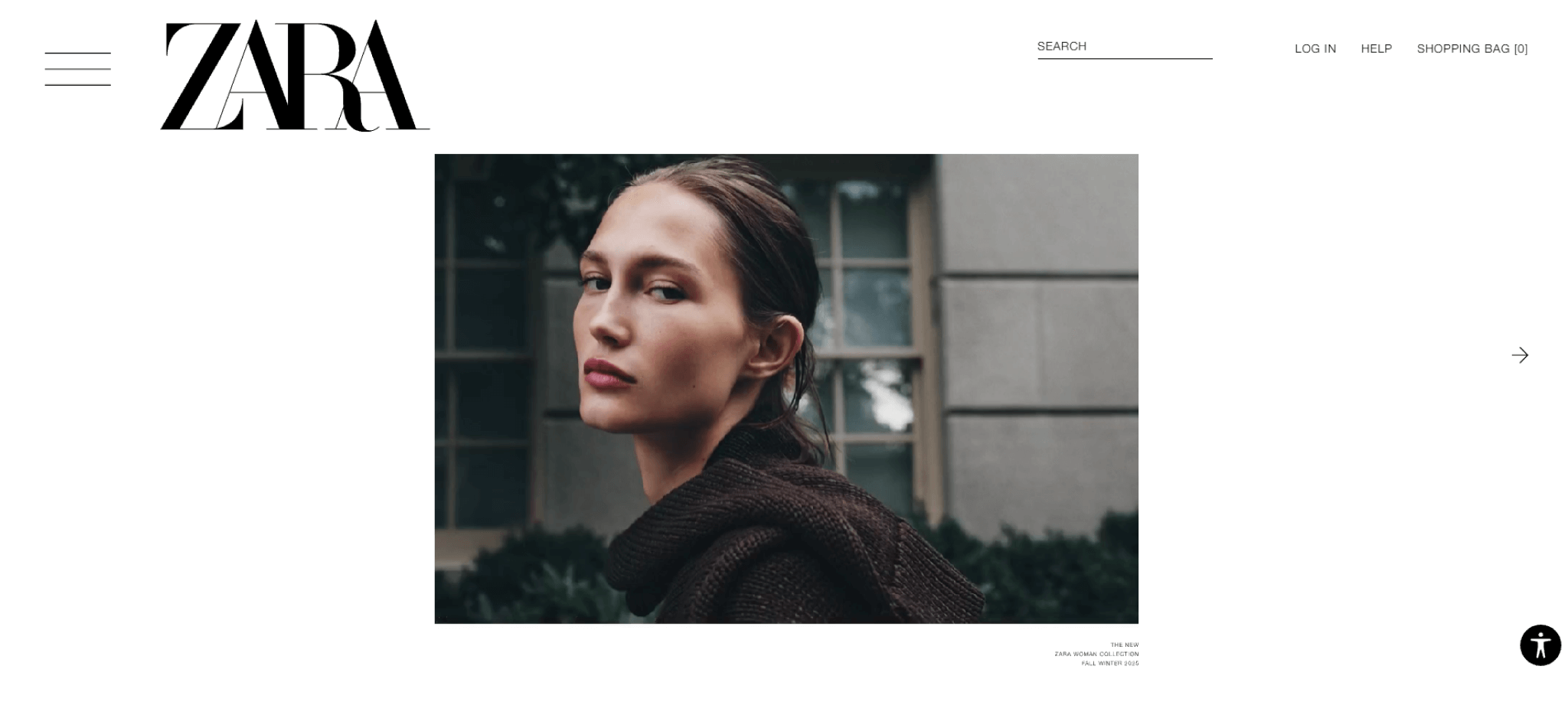
-
H&M – Trend Forecasting with Big Data
H&M leverages AI to analyze social media, search data, and customer feedback. This helps predict what styles will be in demand and informs the design and production process accordingly.
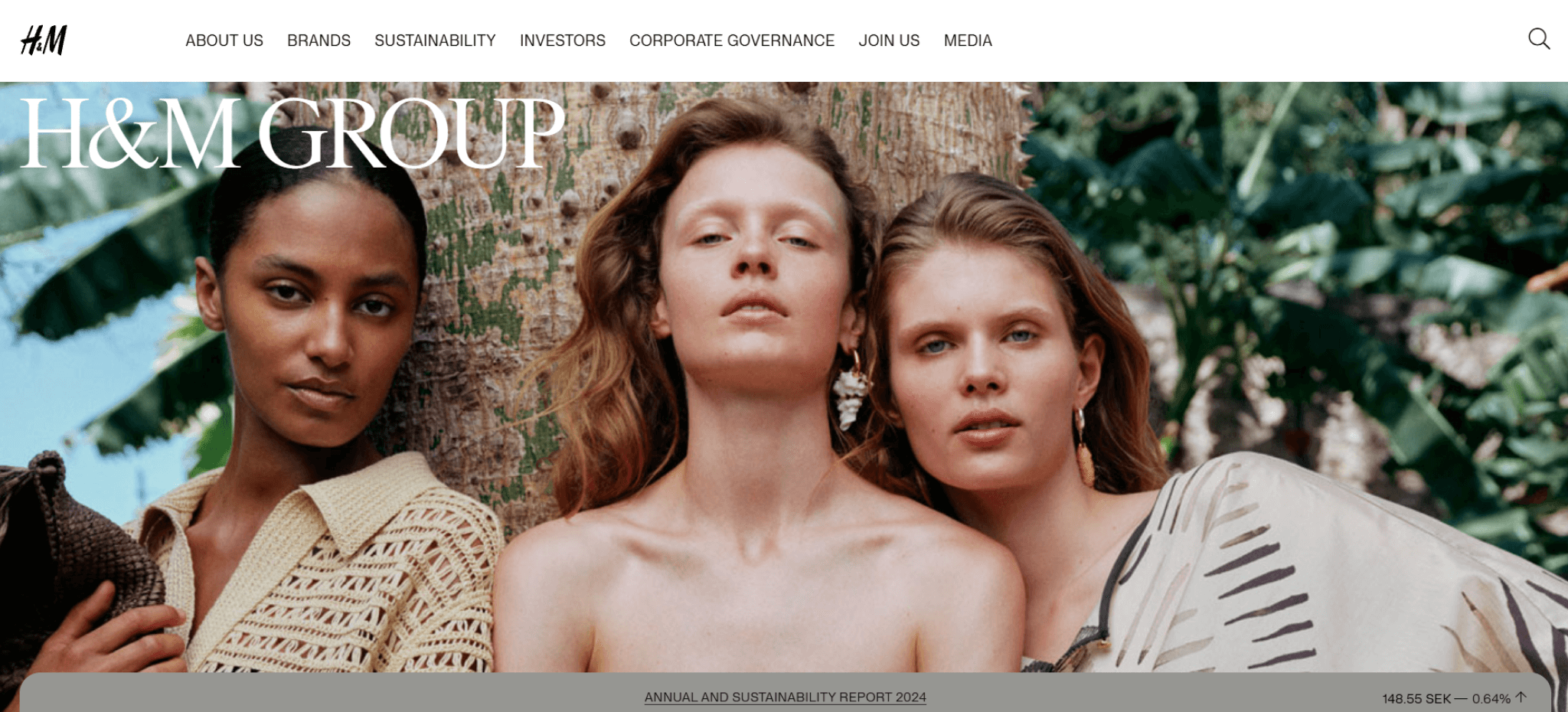
-
Nike – Personalized Shopping Experience
Nike uses AI in its mobile app to recommend products based on user behavior and preferences. Features like virtual try-ons and fit predictions improve the shopping experience and reduce return rates.
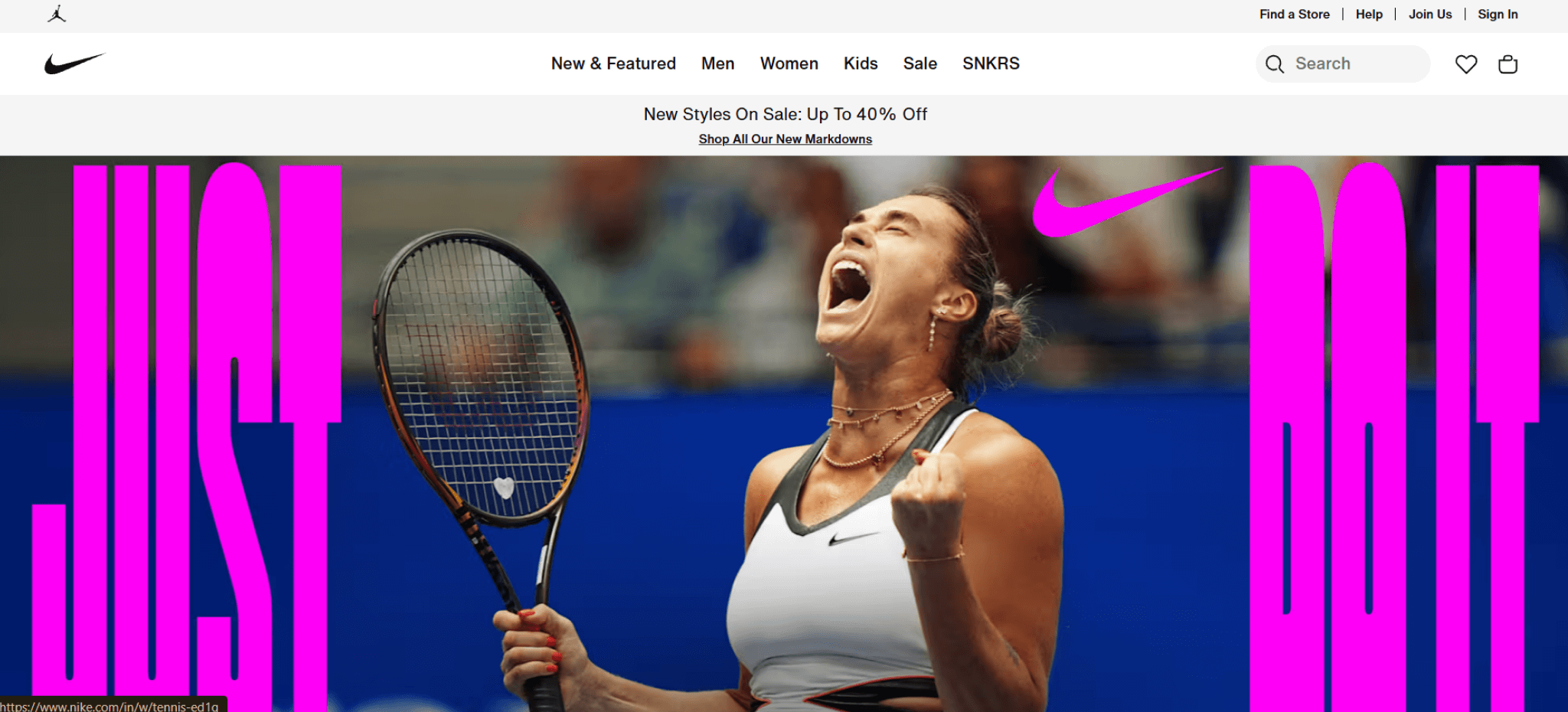
-
Stitch Fix – AI + Human Stylists
Stitch Fix combines AI algorithms with human stylists to curate personalized clothing boxes. The AI filters options based on size, style, and feedback, while stylists add a human touch to final selections.
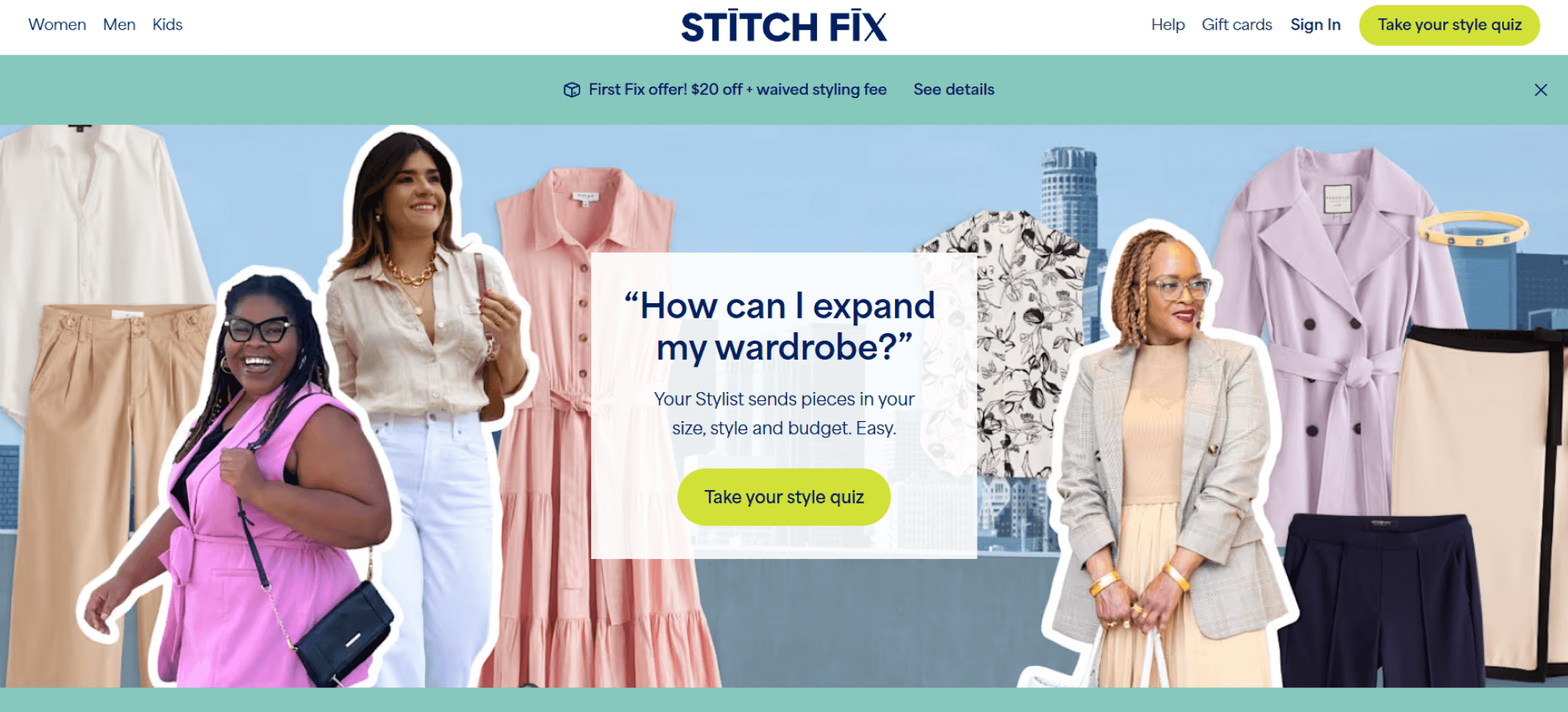
-
Tommy Hilfiger – AI in Design Process
Partnering with IBM and the Fashion Institute of Technology, Tommy Hilfiger uses AI to analyze trends, colors, and consumer data. This insight helps designers create collections that align with customer expectations.
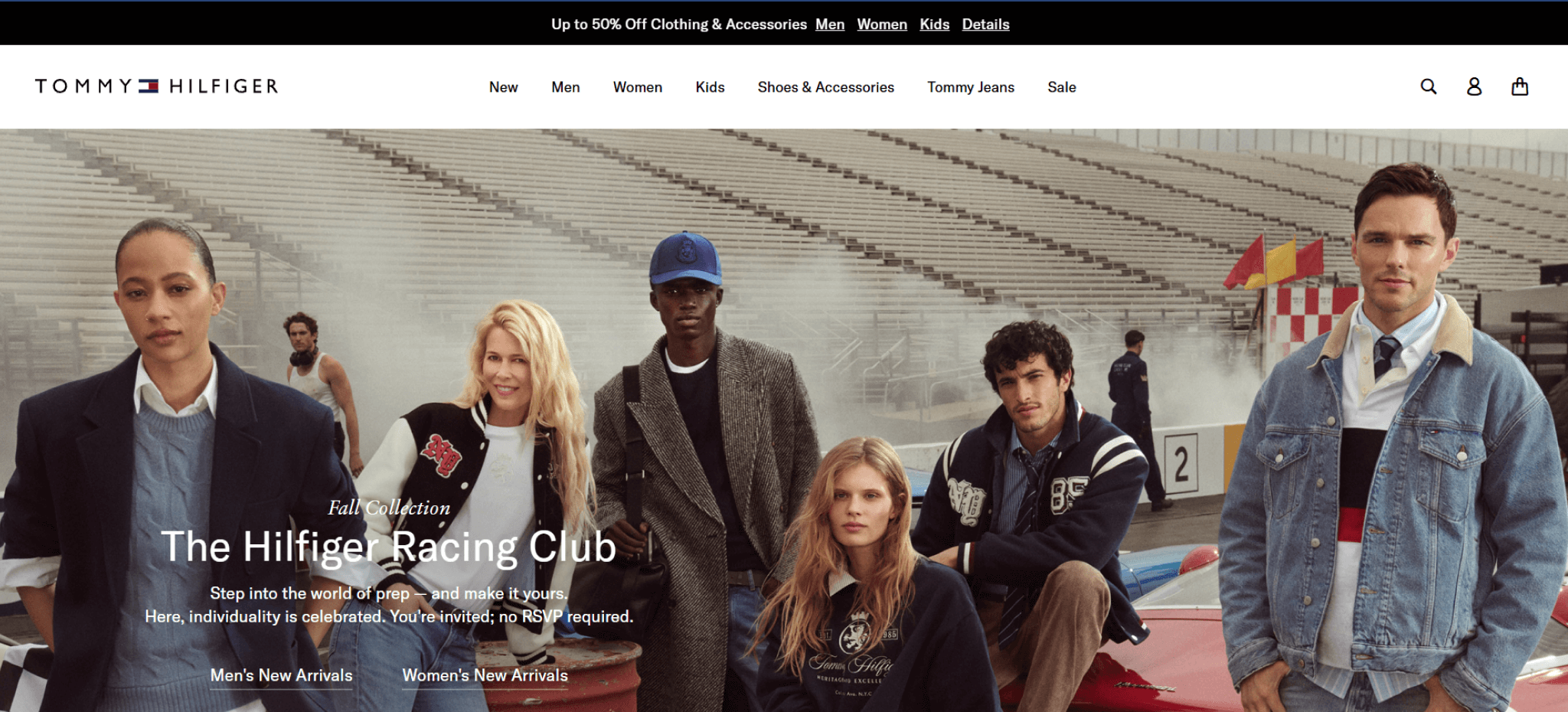
Future of AI in the Fashion Industry
As AI technology advances, its impact on the fashion industry will continue to grow. Here are the key trends that will shape the future of AI in fashion:
1. Sustainable Fashion: AI will optimize supply chains, reduce waste, and improve efficiency to make fashion more sustainable and environmentally friendly.
2. Influencer Marketing 2.0: AI will analyze social media data to identify the most influential bloggers and personalities, helping fashion companies reach their target audience.
3. Trend Forecasting: AI will continue to analyze social media, runways, and street style to predict fashion trends accurately, allowing brands to stay ahead of the curve.
4. AI-Generated Designs: Designers will use AI to combine images of different clothing items, creating innovative and unexpected fashion designs.
5. Personalized Fashion Advice: AI-powered chatbots will provide customers with tailored fashion guidance, taking into account their body type, style preferences, and previous purchases.
6. Virtual Try on Apps: Recently, Doppl, a Google Labs app launched in June 2025, enables AI-powered virtual try‑ons by putting your uploaded full‑body photo into static or animated outfit previews, supporting tops, bottoms, dresses, saving, and sharing styles. We can expect more such platforms and solutions.
As AI continues to transform the fashion industry, ethical and privacy concerns will need to be addressed.
Conclusion
From predicting trends and managing inventory to designing collections and offering personalized shopping experiences, AI is streamlining operations and enhancing customer satisfaction. It empowers brands to be more agile, data-driven, and sustainable in an ever-evolving market. For brands looking to stay competitive and relevant, using AI isn’t just an option; it’s a necessity to stay ahead in the market.
Digital Quest, a travel business, partnered with SoluLab to develop an AI-powered chatbot using Generative AI. The chatbot enhanced customer engagement by offering real-time, personalized travel recommendations and hassle-free reservations. It also integrated user feedback and multi-language support, resulting in improved user experience and high ROI.
SoluLab, a leading AI development company can help you integrate AI in your clothing business to reduce manual work and scale your business. Contact us today to discuss further!
FAQs
1. How can fashion brands quickly implement AI solutions?
Fashion brands can partner with AI development experts to integrate tools like predictive analytics, virtual try-ons, and recommendation engines without overhauling existing systems. Scalable solutions allow quick deployment and measurable ROI.
2. How does AI help in reducing fashion waste?
AI predicts demand accurately and optimizes inventory planning, helping brands avoid overproduction and unsold stock. This not only saves costs but also supports sustainable and eco-friendly practices.
3. Can small or mid-sized fashion brands benefit from AI?
Absolutely. AI isn’t just for large retailers. Even smaller brands can use AI for inventory management, personalized marketing, and customer engagement to compete effectively with bigger players.
4. How does AI help consumers choose the right size?
AI uses past purchase data, body measurements, and sizing patterns to recommend accurate fits. This reduces returns, increases satisfaction, and improves confidence in online shopping.
5. How can AI be integrated into both online and offline retail?
AI solutions are flexible. They can power online experiences like personalized recommendations and virtual try-ons, while also optimizing in-store operations, merchandising, and staff allocation for a seamless omnichannel strategy.






